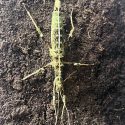
Sunny Stick Insect Natural History
Size
These insects grow to around 85 mm and males are typically smaller than females.
Habitat and Distribution
They can be found in temperate and tropical forests in the Philippines. They are tolerant of both dry and wet conditions and generally prefer to live-in trees and bushes where they camouflage best.
Age
Adult females live for only a few months, they die off each winter but by that stage will have laid eggs.
Diet
They are herbivores feeding on leaves.
Groups and Breeding
To retain genetic diversity the preferred method of reproduction is sexual. However females can reproduce parthenogenically. Up to 12 eggs are laid hatching after 6 months.
Threats
Their full status in the wild is not known.
Interesting Facts
The genus Sungaya contains only a single species which wasn’t discovered until 1995 when a young female was collected followed by an adult female in 1996. A male wasn’t seen for the first time until 2008.
The Sunny Stick Insect During Your Day Out in Kent
Our Sunny Stick Insects can be seen in our Bug House along side a number of other species including Red Clawed Crabs, Unicorn Snails and Leaf Cutter Ants.